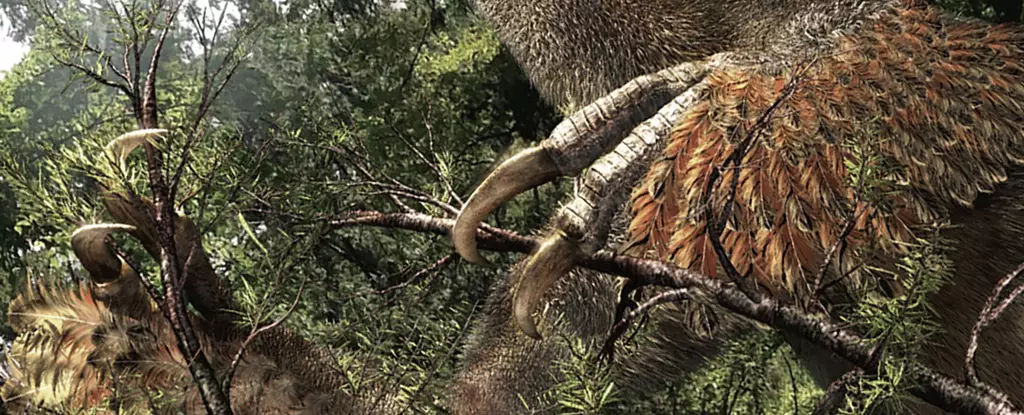In the vast expanse of the Gobi Desert, an extraordinary find has emerged—one of the most astonishing dinosaur fossils to date, heralding not just a deeper understanding of these ancient creatures, but also an urgent re-evaluation of evolutionary norms within the theropod family. The paleontological community is aflutter with the discovery of Duonychus tsogtbaatari, a newly identified feathered dinosaur possessing an unexpected two-fingered hand structure, challenging long-held beliefs about the evolutionary adaptations of therizinosaurs. The implications of this discovery reach far beyond mere curiosity, compelling scientists to interrogate the very mechanisms that govern evolution in highly specialized environments.
A Unique Anatomical Structure
What sets Duonychus apart from its relatives is its remarkable anatomical configuration; rather than the commonly accepted three-fingered hands typical among therizinosaurs, this species exhibits an eccentric yet compelling adaptation—two massive claws, each extending nearly 30 centimeters. These formidable appendages were not merely for show; they were intricately designed for a specific purpose in the dinosaur’s survival toolkit. The keratin sheath extending from the bones suggests that Duonychus’s claws were not only menacing but also indicative of a sophisticated feeding mechanism, hinting at a relationship with its food sources that is both unique and informative.
Dr. Kobayashi, who led the research team from the Mongolian Academy of Sciences, stresses the significance of this find. This unique anatomical trait opens up a Pandora’s box of questions regarding the evolutionary pathways of theropods, and particularly therizinosaurs. Why did Duonychus diverge from the three-fingered norm? Was this a result of environmental pressures, dietary needs, or perhaps an influence of competition? Just as every clue in forensic science can shift the narrative, Duonychus forces a reevaluation of assumptions that had previously remained unchallenged.
A Window into Evolutionary Adaptation
The fossil itself comes from the Bayanshiree Formation, a hotbed for significant paleontological discoveries. This region’s arid landscape and rich sedimentary deposits have preserved a timeline of prehistoric life, including giant pterosaurs and other formidable dinosaurs. The Jurassic era remains a fascinating chapter to explore, and discoveries like Duonychus tsogtbaatari are pivotal to understanding how these ancient organisms adapted to their environments over millions of years.
One can’t help but marvel at the fact that these claws—broad, lethal, and yet delicately preserved—have survived the test of time when keratin typically degrades long before bone. The intact constitution of these features speaks to the conditions prevalent in the Gobi Desert, belying the complexity of geological processes involved in fossilization. Herein lies a vital point of curiosity: if Duonychus’s peculiar evolutionary choice has been preserved, what else remains yet to be discovered in this ancient landscape?
The Bigger Picture of Biodiversity
The discovery of Duonychus also serves as a reminder that biodiversity—past and present—is not merely linear but a convoluted web of adaptations and characteristics shaped by countless environmental variables. The practice of subdividing organisms into simplistic categories often obscures the reality of their complexities. This fossil challenges our simplistic classifications by presenting a dinosaur that defies earlier expectations, suggesting that adaptability can manifest through astonishing variety even within closely related species.
Furthermore, today’s scientific community grapples with questions regarding the potential parallels between ancient and contemporary biodiversity. While Duonychus thrived in the Cretaceous, modern ecosystems showcase a similar diversity of adaptable traits. As we face a climate crisis today, the evolutionary stories locked within fossils like Duonychus tsogtbaatari may shed light on how life can endure and adapt in the face of changing ecological pressures.
Concluding Thoughts on Uncharted Horizons
What has been unearthed with Duonychus tsogtbaatari is not just a fossil, but a compelling invitation to observe, inquire, and reimagine the narrative of life’s evolution. It forces us to embrace the complexities inherent in the natural world and recognize that adaptation is not a simple evolutionary response but a multifaceted interplay between an organism and its environment.
Thus, as we delve deeper into the fossil record, each new find like Duonychus may reveal a universe of hidden knowledge, waiting to expand our understanding of how life, in all its forms, continues to navigate the intricate dance of survival. Keep your eyes on the Gobi, for the sands of time may yield yet more enigmas to explore.


Leave a Reply